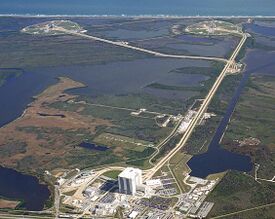Astronomy:Crawlerway
Crawlerway | |
 Aerial view of Launch Complex 39. The Crawlerway is the pathway between the Vehicle Assembly Building and Pads 39A and 39B. | |
| Lua error in Module:Location_map at line 522: Unable to find the specified location map definition: "Module:Location map/data/Florida" does not exist. | |
| Location | Brevard County, Florida |
|---|---|
| Nearest city | Merritt Island |
| Coordinates | [ ⚑ ] : 28°36′13″N 80°37′39″W / 28.60361°N 80.6275°W |
| Built | 1964 |
| MPS | John F. Kennedy Space Center MPS |
| NRHP reference # | 99001641[1] |
| Added to NRHP | January 21, 2000 |
The Crawlerway is a 130-foot-wide (40 m)[2] double pathway at the Kennedy Space Center in Florida. It runs between the Vehicle Assembly Building and the two launch pads at Launch Complex 39. It has a length of 3.4 and 4.2 miles (5.5 and 6.8 km) to Pad 39A and Pad 39B, respectively. A seven-foot (2 m) bed of stones lies beneath a layer of asphalt and a surface made of Alabama river rocks.
The Crawlerway was originally designed to support the weight of the Saturn V rocket and its payload, plus the Launch Umbilical Tower and mobile launcher platform, atop a crawler-transporter during the Apollo program. It was also used from 1981 to 2011 to transport the lighter Space Shuttles to their launch pads.
Construction of the Crawlerway connected Merritt Island with the mainland, forming a peninsula. The main vehicle access road to and from the launch pads, the Saturn Causeway, runs alongside the Crawlerway.
Construction
The Crawlerway is composed of two 40-foot-wide (12 m) lanes, separated by a 50-foot (15 m) median. The top layer is Alabama river rock, 4 inches (10 cm) thick on the straight sections and 8 inches (20 cm) thick on curves. Alabama river rock was chosen for many properties, including hardness, roundness, sphericity and LA abrasion test score.[3] Beneath that is 4 feet (1.2 m) of graded, crushed stone, resting on two layers of fill.[2] By 2013, a project to repair and upgrade the Crawlerway was undertaken, the first time since it was constructed that the foundation had been repaired. Additional rock was added to the surface in June 2014.[4]
Gallery
Apollo 14 rolls to Pad 39A in November 1970
The prototype Space Shuttle Enterprise begins its journey down the Crawlerway from Pad 39A to the VAB in July 1979 following a series of fit-checks
References
- ↑ "National Register Information System". National Register of Historic Places. National Park Service. July 9, 2010. https://npgallery.nps.gov/NRHP.
- ↑ 2.0 2.1 "Mobile Launcher Platform". NASA Facts. NASA. October 1991. http://www-pao.ksc.nasa.gov/nasafact/count3teaf.htm.
- ↑ Vaughan, Robert. "NASA Crawlerway Foundation and Compatibility Study". https://www.jonesedmunds.com/portfolio-works/nasa-crawlerway-foundation-compatibility-study/.
- ↑ Herridge, Linda (February 22, 2013). "Upgrades Will Prepare Crawlerway for Space Launch System". NASA. https://www.nasa.gov/exploration/systems/ground/crawlerway_upgrades.html. Retrieved December 13, 2013.
External links
 |






